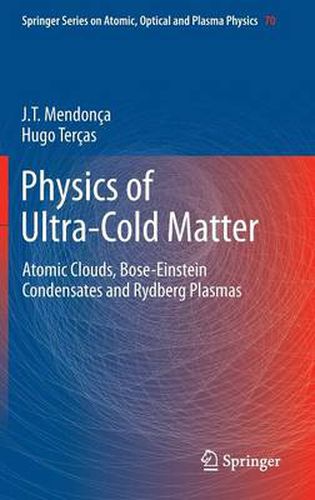Readings Newsletter
Become a Readings Member to make your shopping experience even easier.
Sign in or sign up for free!
You’re not far away from qualifying for FREE standard shipping within Australia
You’ve qualified for FREE standard shipping within Australia
The cart is loading…






This title is printed to order. This book may have been self-published. If so, we cannot guarantee the quality of the content. In the main most books will have gone through the editing process however some may not. We therefore suggest that you be aware of this before ordering this book. If in doubt check either the author or publisher’s details as we are unable to accept any returns unless they are faulty. Please contact us if you have any questions.
The advent of laser cooling of atoms led to the discovery of ultra-cold matter, with temperatures below liquid Helium, which displays a variety of new physical phenomena. Physics of Ultra-Cold Matter gives an overview of this recent area of science, with a discussion of its main results and a description of its theoretical concepts and methods.
Ultra-cold matter can be considered in three distinct phases: ultra-cold gas, Bose Einstein condensate, and Rydberg plasmas. This book gives an integrated view of this new area of science at the frontier between atomic physics, condensed matter, and plasma physics. It describes these three distinct phases while exploring the differences, as well as the sometimes unexpected similarities, of their respective theoretical methods.
This book is an informative guide for researchers, and the benefits are a result from an integrated view of a very broad area of research, which is limited in previous books about this subject. The main unifying tool explored in this book is the wave kinetic theory based on Wigner functions. Other theoretical approaches, eventually more familiar to the reader, are also given for extension and comparison. The book considers laser cooling techniques, atom-atom interactions, and focuses on the elementary excitations and collective oscillations in atomic clouds, Bose-Einstein condensates, and Rydberg plasmas. Linear and nonlinear processes are considered, including Landau damping, soliton excitation and vortices. Atomic interferometers and quantum coherence are also included.
$9.00 standard shipping within Australia
FREE standard shipping within Australia for orders over $100.00
Express & International shipping calculated at checkout
This title is printed to order. This book may have been self-published. If so, we cannot guarantee the quality of the content. In the main most books will have gone through the editing process however some may not. We therefore suggest that you be aware of this before ordering this book. If in doubt check either the author or publisher’s details as we are unable to accept any returns unless they are faulty. Please contact us if you have any questions.
The advent of laser cooling of atoms led to the discovery of ultra-cold matter, with temperatures below liquid Helium, which displays a variety of new physical phenomena. Physics of Ultra-Cold Matter gives an overview of this recent area of science, with a discussion of its main results and a description of its theoretical concepts and methods.
Ultra-cold matter can be considered in three distinct phases: ultra-cold gas, Bose Einstein condensate, and Rydberg plasmas. This book gives an integrated view of this new area of science at the frontier between atomic physics, condensed matter, and plasma physics. It describes these three distinct phases while exploring the differences, as well as the sometimes unexpected similarities, of their respective theoretical methods.
This book is an informative guide for researchers, and the benefits are a result from an integrated view of a very broad area of research, which is limited in previous books about this subject. The main unifying tool explored in this book is the wave kinetic theory based on Wigner functions. Other theoretical approaches, eventually more familiar to the reader, are also given for extension and comparison. The book considers laser cooling techniques, atom-atom interactions, and focuses on the elementary excitations and collective oscillations in atomic clouds, Bose-Einstein condensates, and Rydberg plasmas. Linear and nonlinear processes are considered, including Landau damping, soliton excitation and vortices. Atomic interferometers and quantum coherence are also included.